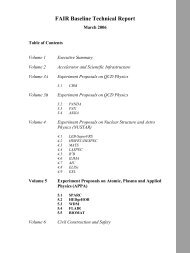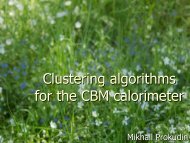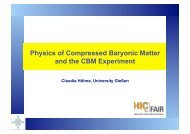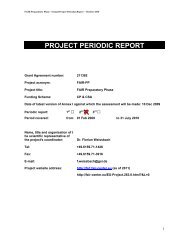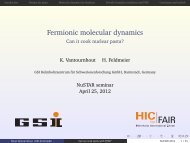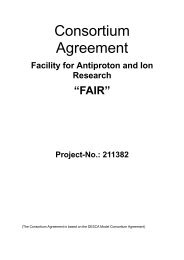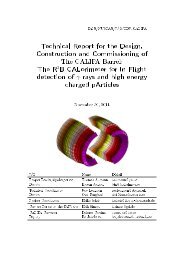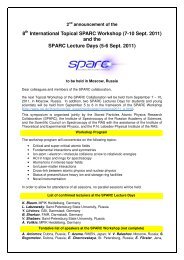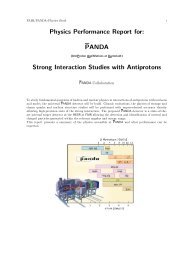NeuLAND - FAIR
NeuLAND - FAIR
NeuLAND - FAIR
You also want an ePaper? Increase the reach of your titles
YUMPU automatically turns print PDFs into web optimized ePapers that Google loves.
Figure 4.12.: Displayed is a side view of <strong>NeuLAND</strong> together with the interaction of one<br />
incoming neutron at 1000 MeV. In blue we see the track of the incoming<br />
neutron from the left hand side. After interaction in one of the first layers,<br />
one fast proton is traversing part of the detector (red), while the neutron is<br />
scattered. Several other neutrons with short tracks and gammas (in green)<br />
are visible. The display was created using GEANT4.<br />
4.5.1. One-Neutron Response<br />
Regarding first the key quantity, the detection efficiency, the advantage of a fully-active<br />
detector over a converter-based one, manifests itself predominantly at lower neutron<br />
energies, see section 4.2 and table 4.3 as well. For the final detector design, simulated<br />
here, we find a value of 90% efficiency of 200 MeV neutrons, 94% at 600 and 96% at<br />
1000 MeV, respectively 2 . The submodule multiplicity for 200 MeV neutrons amounts to<br />
about 4, for 600 MeV neutrons on average about 14 paddles have a valid entry, and for<br />
1000 MeV per neutron, 25 paddles are involved.<br />
4.5.2. Multi-Neutron Response<br />
The following criteria are used in order to identify and resolve multi-neutron events:<br />
1. The number of incident neutrons. It has to be determined as unambiguous as<br />
possible.<br />
2. The momentum of each identified neutron. It has to be resolved with good resolution.<br />
2 These values comprise the loss of neutrons due to interactions in air for the distance of 15.5 m between<br />
52<br />
target and detector, an effect of 1 to 2%





